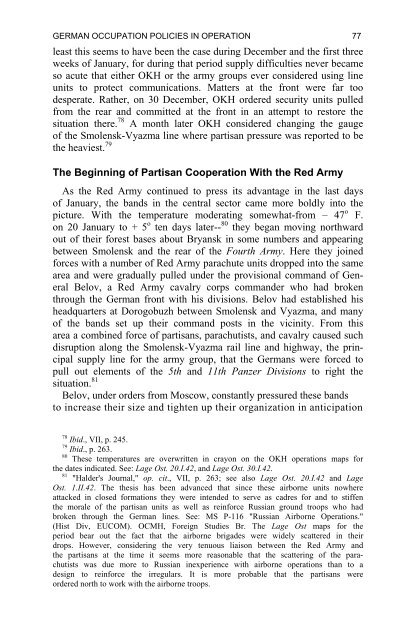the soviet partisan movement 1941-1944 by edgar m. howell
the soviet partisan movement 1941-1944 by edgar m. howell
the soviet partisan movement 1941-1944 by edgar m. howell
You also want an ePaper? Increase the reach of your titles
YUMPU automatically turns print PDFs into web optimized ePapers that Google loves.
GERMAN OCCUPATION POLICIES IN OPERATION 77<br />
least this seems to have been <strong>the</strong> case during December and <strong>the</strong> first three<br />
weeks of January, for during that period supply difficulties never became<br />
so acute that ei<strong>the</strong>r OKH or <strong>the</strong> army groups ever considered using line<br />
units to protect communications. Matters at <strong>the</strong> front were far too<br />
desperate. Ra<strong>the</strong>r, on 30 December, OKH ordered security units pulled<br />
from <strong>the</strong> rear and committed at <strong>the</strong> front in an attempt to restore <strong>the</strong><br />
situation <strong>the</strong>re. 78 A month later OKH considered changing <strong>the</strong> gauge<br />
of <strong>the</strong> Smolensk-Vyazma line where <strong>partisan</strong> pressure was reported to be<br />
<strong>the</strong> heaviest. 79<br />
The Beginning of Partisan Cooperation With <strong>the</strong> Red Army<br />
As <strong>the</strong> Red Army continued to press its advantage in <strong>the</strong> last days<br />
of January, <strong>the</strong> bands in <strong>the</strong> central sector came more boldly into <strong>the</strong><br />
picture. With <strong>the</strong> temperature moderating somewhat-from – 47 o F.<br />
on 20 January to + 5 o ten days later-- 80 <strong>the</strong>y began moving northward<br />
out of <strong>the</strong>ir forest bases about Bryansk in some numbers and appearing<br />
between Smolensk and <strong>the</strong> rear of <strong>the</strong> Fourth Army. Here <strong>the</strong>y joined<br />
forces with a number of Red Army parachute units dropped into <strong>the</strong> same<br />
area and were gradually pulled under <strong>the</strong> provisional command of General<br />
Belov, a Red Army cavalry corps commander who had broken<br />
through <strong>the</strong> German front with his divisions. Belov had established his<br />
headquarters at Dorogobuzh between Smolensk and Vyazma, and many<br />
of <strong>the</strong> bands set up <strong>the</strong>ir command posts in <strong>the</strong> vicinity. From this<br />
area a combined force of <strong>partisan</strong>s, parachutists, and cavalry caused such<br />
disruption along <strong>the</strong> Smolensk-Vyazma rail line and highway, <strong>the</strong> principal<br />
supply line for <strong>the</strong> army group, that <strong>the</strong> Germans were forced to<br />
pull out elements of <strong>the</strong> 5th and 11th Panzer Divisions to right <strong>the</strong><br />
situation. 81<br />
Belov, under orders from Moscow, constantly pressured <strong>the</strong>se bands<br />
to increase <strong>the</strong>ir size and tighten up <strong>the</strong>ir organization in anticipation<br />
78<br />
Ibid., VII, p. 245.<br />
79<br />
Ibid., p. 263.<br />
80 These temperatures are overwritten in crayon on <strong>the</strong> OKH operations maps for<br />
<strong>the</strong> dates indicated. See: Lage Ost. 20.I.42, and Lage Ost. 30.I.42.<br />
81 "Halder's Journal," op. cit., VII, p. 263; see also Lage Ost. 20.I.42 and Lage<br />
Ost. 1.II.42. The <strong>the</strong>sis has been advanced that since <strong>the</strong>se airborne units nowhere<br />
attacked in closed formations <strong>the</strong>y were intended to serve as cadres for and to stiffen<br />
<strong>the</strong> morale of <strong>the</strong> <strong>partisan</strong> units as well as reinforce Russian ground troops who had<br />
broken through <strong>the</strong> German lines. See: MS P-116 "Russian Airborne Operations."<br />
(Hist Div, EUCOM). OCMH, Foreign Studies Br. The Lage Ost maps for <strong>the</strong><br />
period bear out <strong>the</strong> fact that <strong>the</strong> airborne brigades were widely scattered in <strong>the</strong>ir<br />
drops. However, considering <strong>the</strong> very tenuous liaison between <strong>the</strong> Red Army and<br />
<strong>the</strong> <strong>partisan</strong>s at <strong>the</strong> time it seems more reasonable that <strong>the</strong> scattering of <strong>the</strong> parachutists<br />
was due more to Russian inexperience with airborne operations than to a<br />
design to reinforce <strong>the</strong> irregulars. It is more probable that <strong>the</strong> <strong>partisan</strong>s were<br />
ordered north to work with <strong>the</strong> airborne troops.
















